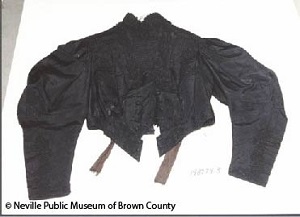Who is Eveline Scheckler?
African American Settlement in Nineteenth Century Brown County
Eveline Scheckler, an African American woman, lived in De
Pere from 1848 until her death in 1871. Though it is not widely known today, in
the nineteenth century a small but steadily growing population of African
Americans made Northeast Wisconsin their home. Eveline was one member of this
community. The number of African Americans living here peaked in the 1890s, and
plummeted in the early twentieth century. As a historian, this demographic data
identifies a story I really want to understand. I began researching the history
of African Americans in Northeast Wisconsin in 2011.
Why did Eveline Scheckler Move to De Pere in 1848?
Eveline first appears in the local historical record in
1850. She lived with Rebecca Schell Loy and David Loy, early white De Pere
settlers. The Loys preserved their family papers and donated them to the
Neville Public Museum. Eveline appears in them regularly, which allows us
knowledge of certain aspects of her life.
In Pennsylvania in 1825, Peter Schell, father of Rebecca,
took in the orphaned five-year-old Eveline. Eveline and Rebecca grew up
together. When Rebecca married and moved to Wisconsin in 1847, Eveline joined
her a year later. The Loy papers indicate that in some ways the Loys saw
Eveline as family, but the papers also indicate a far more complicated story.
In language evoking a very different status, one Loy identified Eveline as “our
colored maid.” Eveline lived with the Loys until her death in 1871, cooking for
the family and helping to raise their sons.
 |
| Eveline is buried with the Loy Family at Woodlawn Cemetery in Green Bay. |
What don’t we know about Eveline Scheckler?
Numerous aspects of Eveline’s life remain unknown. How was
she orphaned; why did she land in the Schell home? Who were her parents; what
were their lives? Documentation expanding our knowledge of her early life might
exist in Pennsylvania, so some of these questions may be answerable. What will
probably never be found are sources giving us Eveline’s own telling of her life
story. The primary sources we draw upon to understand the past reflect the
American history of white supremacy and injustices. The written sources
available to us are influenced by many things. Who can read and write, and thus
record their experiences and perspectives? What documents are kept; which are
discarded? Which make it into archives and are thus available to researchers like
me? In short, whose voices get preserved, and whose voices are misrepresented
or omitted? As an African American servant in the mid-nineteenth century,
Eveline was one of many people who were unlikely to be able to accurately
record their own lives. Our knowledge of Eveline Scheckler comes only from the
perspective of those who, though they said they loved her, also ascribed her
servile status.
Women’s History Month
Aspects of Eveline’s life illustrate broader elements of
African American women’s history. Racism limited the jobs open to free African
American women and directed them disproportionately to domestic work. Northeast
Wisconsin was no exception to this phenomenon. In a parallel to Eveline’s
experience, many other African American women living here in the nineteenth
century worked as servants, washerwomen, seamstresses, milliners, and
hairdressers.
Victoria B. Tashjian
Professor of History
St. Norbert College



Comments
Post a Comment